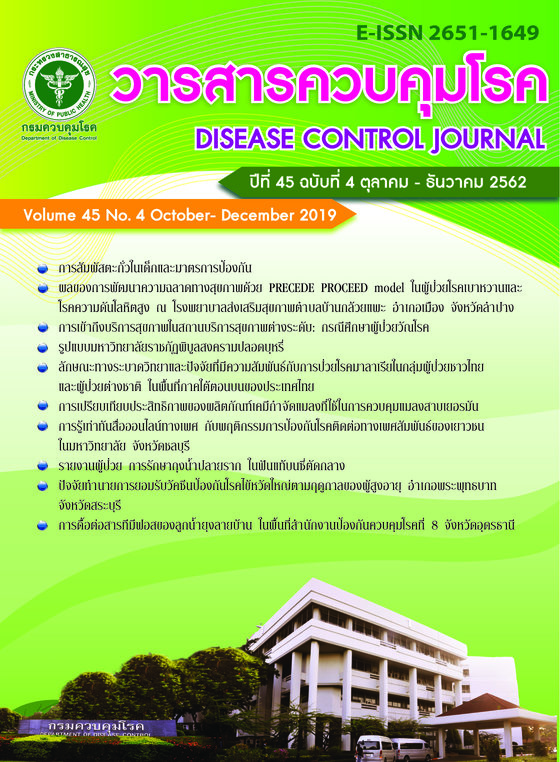Sexual media literacy and preventive behaviors about sexually transmitted diseases among youth in university students Chon Buri Province, Thailand
DOI:
https://doi.org/10.14456/dcj.2019.37Keywords:
sexual media literacy, behaviors, sexually transmitted diseases, adolescent, universityAbstract
Sexually transmitted diseases (STDs) are a significant health problem among youth. Sexual media literacy is a significant factor related to preventing STDs. The aim of this cross-sectional study was to examine sexual media literacy and preventive behaviors regarding STDs among university students. The participants were 485 male and female university students aged >18 years. Data was collected using a self-administered questionnaire, analyzed using descriptive statistics, and presented to show the frequency, percentage, mean, minimum, maximum, and standard deviation (SD). Correlations were determined using chi-squared statistical methods. The results revealed that 86.4% of university students are heterosexual, 62.1% had sexual intercourse, and 17.9% viewed sexual media at least five times per week. More than half had access to internet pornography. Only one-fifth had good sexual media literacy. Nearly half of the students exhibited inappropriate behaviors toward preventing STDs. Significant factors that correlated with preventative behaviors included sex (p<0.001), gender (p=0.031), living situation (p=0.014), relationships with casual partners (p<0.001), frequency of using sexual media (p=0.018), and sexual media literacy (p<0.001), with a statistical significance of 0.05. The results showed that youth with low sexual media literacy were more likely to exhibit inappropriate preventive behaviors regarding STDs. Stakeholders, therefore, must work toward improving sexual media literacy, specifically regarding inappropriate preventive behaviors regarding STDs, especially for youth who live alone or with their sexual partner.
Downloads
References
2. White CM. Social media, crisis communication, and emergency management leveraging web 2.0 technologies. Boca Raton: CRC; 2012.
3. ETDA. ETDA reveals the survey results of internet usage behavior of Thai people in 2016. [Internet]. [cited 2016 Aug 18]. Available from: https://www.marketingoops.com/reports/behaviors/etda-research-thai-internet-2016/ (in Thai)
4. NIDA Poll. Social media and the future of Thai youth [Internet]. 2017 [cited 2018 Aug 8]. Available from: https://nidapoll.nida.ac.th/index.php?op=polls-detail&id=523 (in Thai)
5. Pounglek W. Internet pornography: risk caution and prevention guideline against its effects on Thai youth. Executive Journal 2010;31:223-33. (in Thai)
6. Buranasin T. Kids addict "pornographic online" leading sexual risk behavior and teenage pregnancy 2014 [Internet]. [cited 2018 Aug 21]. Available from: https://www.thaihealth.or.th/Content/25258-ลูกเสพสื่อลามกออนไลน์สร้างปัญหาแม่วัยใส-ภัยทางเพศ.html (in Thai)
7. Tansuwannond C, Wongpinpech P, Leesattrupa C. Factors related to intellectual media consumption behavior of undergraduate students in Bangkok. Journal of Behavioral Science 2010;16:122-35. (in Thai)
8. Chirawatkul S, Sawangchareon K, Rujiraprasert N, Kittiwatanapaisan W, Muangpin S, Kotnara I, et al. Situation of teenage pregnancy: perception among adolescents in 7 provinces of Thailand. Journal of Health Science 2012;21:865-77. (in Thai)
9. Wattradul D. Developing model of health promoting behavior in preventing HIV and STDs in the youths in the city. Journal of Nursing Science & Health 2016;39:24-36. (in Thai)
10. United Nations Educational, Scientific and Cultural Organization. Media and information literacy: policy and strategy guidelines. France: United Nations Educational, Scientific and Cultural Organization; 2013.
11. Kuysuwan K, Supparerkchaisakul N, Chuawanlee W, Intarakamhang U. Causal factors of HIV/AIDS safe sex behavior among Thai Navy Conscripts: the study of change during training in the recruitment center and effects of AIDS risk reduction program. Journal of Behavioral Science 2013;19:35-58. (in Thai)
12. Devellis RF. Scale development: theory and applications. Thousand Oaks: Sage publications; 2016.
13. Nutbeam D. The evolving concept of health literacy. Soc Sci Med 2008;67:2072-8.
14. Thanarak R. Media literacy: advantages and applications a case study of Uttaradit Rajabhat University [dissertation]. Uttaradit: Uttaradit Rajabhat University; 2015. 96 p. (in Thai)
15. Pakdeemulchon A, Rattanasimakul K. Factor impacting media-literacy on sex among undergraduate students in Chiang Rai and Chiang Mai. Journal of Management Science Chiangrai Rajabhat University 2017;12:184-204. (in Thai)
16. Tepkamnerd S. Sexual behavior of vocational students at occupational certificate Muang district Narathiwat Province [dissertation]. Chon Buri: Burapha University; 2009. 62 p. (in Thai)
17. Wiboonphan S. Association between social media literacy and sexual behaviors of adolescents in Banglamung District, Chon Buri Province [dissertation]. Chon Buri: Burapha University; 2017. 104 p. (in Thai)
18. Tibwongsa S, Thongnoppakun S. Health literacy of condom-use behavior of men who have sex with men among university students in Chon Buri Province. Journal of Health Education and communication 2018;4:24-36. (in Thai)
19. Pungpapong NP. "Preceptor-receptor" which type leading to HIV infection [Internet]. [cited 2018 Nov 24]. Available from: https://mgronline.com/qol/detail/9570000048643 (in Thai)
20.The Thai Red Cross Society. Situation concern to increasing HIV infection among Thai adolescent 2018 [Internet]. [cited 2018 Nov 22]. Available from: https://www.thaihealth.or.th/Content/41145-สถานการณ์น่าห่วง-วัยรุ่นไทยติดเชื้อ.html (in Thai)
21. Wong-arsa W, Kongnguen P, Vuthiarpa S. Factors affecting sexual risk behaviors among adolescents: a case study conducted in one university. Journal of Public Health 2015;45:285-97. (in Thai)
22. Thepthien B, Trakoolvongse P. Sexual behavioral survey 6 target groups in Bangkok, 2005. Journal of Public Health and Development 2005;4:1-15. (in Thai)
23. Tipwareerom W. Research and development to create prevent sexual risk behavior network team for adolescent in community [dissertation]. Phitsanulok: Naresuan University; 2015. 122 p. (in Thai)
24. Kaihin R. Effects of empowerment on reduction risk behaviors among youth living with HIV/AIDS. Nursing Journal 2012;39:38-50. (in Thai)
25. Santawee K. Media exposure and media literacy of youths in Bangkok [dissertation]. Bangkok: Rajamangala University of Technology Phra Nakhon; 2009. 69 p. (in Thai)
26. Siricharoen N. Communication for the knowledge building and skills enhancing in the in-depth internet literacy level of Thai youths from the three main components. Veridian E-Journal, Silpakorn University 2014;7:322-41. (in Thai)
Downloads
Published
How to Cite
Issue
Section
License
Articles published in the Disease Control Journal are considered as academic work, research or analysis of the personal opinion of the authors, not the opinion of the Thailand Department of Disease Control or editorial team. The authors must be responsible for their articles.






